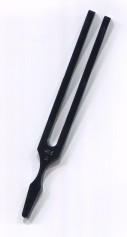Technical Library
TUNING V: Tuning Forks
Entire Contents Copyright © 2024 CBHTechnical LibraryTUNING V: Tuning Forks Entire Contents Copyright © 2024 CBH |
 Tuning
Forks…
Tuning
Forks…
All harpsichordists require a pitch source to ensure their instrument is retuned to the pitch desired by its maker, and the tuning fork remains one of the most convenient, portable and inexpensive means of reproducing a fixed pitch.
The a' is the pitch provided to the modern orchestra by the oboe.
We stock a variety of pitches of high quality blue John Walker tuning forks, but the A415 fork is especially popular for harpsichordists and others involved in early music. A430 is essential for musicians interested in the Classical repertoire.
Some musicians prefer using an electronic tuner or app which allows a hands-free pitch source, as well as dividing up the notes of the scale to produce a temperament, if you desire. Several tuners can be calibrated within a range of pitches handy for early music—others can only be used in a small area around modern A440.
The fork doesn’t make much sound unless you know how to excite it. To use a fork properly, hold the handle and give one of the tines a solid knock against your kneebone. Then rest the base of the fork on the top of the cheek of your harpsichord or the bridge to allow you to hear the pitch clearly.
| TUNING FORK AVAILABILITY — February 2024 | |||
|---|---|---|---|
| Pitch | Availability | ||
| G392 | French Baroque pitch | ✓ | |
| A415 | Baroque pitch | ||
| A430 | Classical pitch | ✓ | |
| A440 | Modern pitch | ||
| Technical Library overview | |
| Harpsichords Australia Home Page |